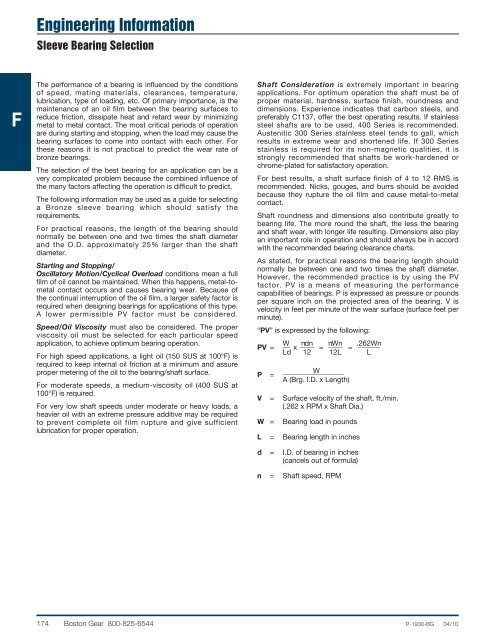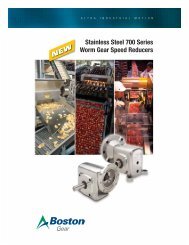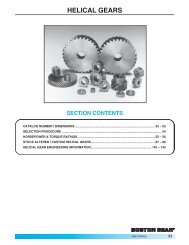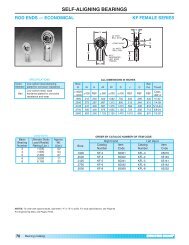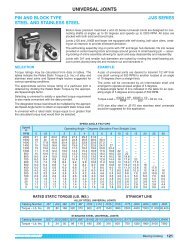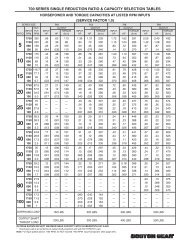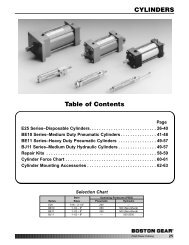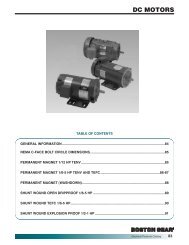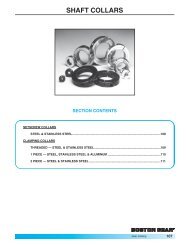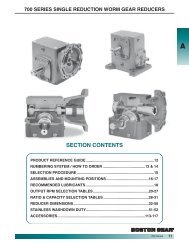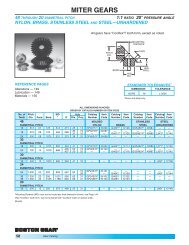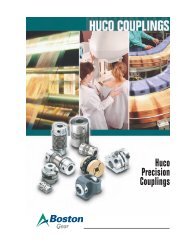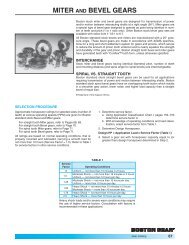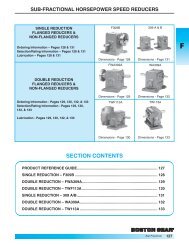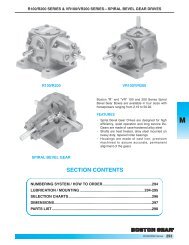Modified Stock Gearing - Boston Gear
Modified Stock Gearing - Boston Gear
Modified Stock Gearing - Boston Gear
You also want an ePaper? Increase the reach of your titles
YUMPU automatically turns print PDFs into web optimized ePapers that Google loves.
Engineering Information<br />
Sleeve Bearing Selection<br />
F<br />
The performance of a bearing is influenced by the conditions<br />
of speed, mating materials, clearances, temperature,<br />
lubrication, type of loading, etc. Of primary importance, is the<br />
maintenance of an oil film between the bearing surfaces to<br />
reduce friction, dissipate heat and retard wear by minimizing<br />
metal to metal contact. The most critical periods of operation<br />
are during starting and stopping, when the load may cause the<br />
bearing surfaces to come into contact with each other. For<br />
these reasons it is not practical to predict the wear rate of<br />
bronze bearings.<br />
The selection of the best bearing for an application can be a<br />
very complicated problem because the combined influence of<br />
the many factors affecting the operation is difficult to predict.<br />
The following information may be used as a guide for selecting<br />
a Bronze sleeve bearing which should satisfy the<br />
requirements.<br />
For practical reasons, the length of the bearing should<br />
normally be between one and two times the shaft diameter<br />
and the O.D. approximately 25% larger than the shaft<br />
diameter.<br />
Starting and Stopping/<br />
Oscillatory Motion/Cyclical Overload conditions mean a full<br />
film of oil cannot be maintained. When this happens, metal-tometal<br />
contact occurs and causes bearing wear. Because of<br />
the continual interruption of the oil film, a larger safety factor is<br />
required when designing bearings for applications of this type.<br />
A lower permissible PV factor must be considered.<br />
Speed/Oil Viscosity must also be considered. The proper<br />
viscosity oil must be selected for each particular speed<br />
application, to achieve optimum bearing operation.<br />
For high speed applications, a light oil (150 SUS at 100°F) is<br />
required to keep internal oil friction at a minimum and assure<br />
proper metering of the oil to the bearing/shaft surface.<br />
For moderate speeds, a medium-viscosity oil (400 SUS at<br />
100°F) is required.<br />
For very low shaft speeds under moderate or heavy loads, a<br />
heavier oil with an extreme pressure additive may be required<br />
to prevent complete oil film rupture and give sufficient<br />
lubrication for proper operation.<br />
Shaft Consideration is extremely important in bearing<br />
applications. For optimum operation the shaft must be of<br />
proper material, hardness, surface finish, roundness and<br />
dimensions. Experience indicates that carbon steels, and<br />
preferably C1137, offer the best operating results. If stainless<br />
steel shafts are to be used, 400 Series is recommended.<br />
Austenitic 300 Series stainless steel tends to gall, which<br />
results in extreme wear and shortened life. If 300 Series<br />
stainless is required for its non-magnetic qualities, it is<br />
strongly recommended that shafts be work-hardened or<br />
chrome-plated for satisfactory operation.<br />
For best results, a shaft surface finish of 4 to 12 RMS is<br />
recommended. Nicks, gouges, and burrs should be avoided<br />
because they rupture the oil film and cause metal-to-metal<br />
contact.<br />
Shaft roundness and dimensions also contribute greatly to<br />
bearing life. The more round the shaft, the less the bearing<br />
and shaft wear, with longer life resulting. Dimensions also play<br />
an important role in operation and should always be in accord<br />
with the recommended bearing clearance charts.<br />
As stated, for practical reasons the bearing length should<br />
normally be between one and two times the shaft diameter.<br />
However, the recommended practice is by using the PV<br />
factor. PV is a means of measuring the performance<br />
capabilities of bearings. P is expressed as pressure or pounds<br />
per square inch on the projected area of the bearing. V is<br />
velocity in feet per minute of the wear surface (surface feet per<br />
minute).<br />
“PV” is expressed by the following:<br />
PV = W__ x ____ πdn = ____ πWn = .262Wn ______<br />
Ld 12 12L L<br />
P =<br />
W<br />
_________________<br />
A (Brg. I.D. x Length)<br />
V = Surface velocity of the shaft, ft./min.<br />
(.262 x RPM x Shaft Dia.)<br />
W = Bearing load in pounds<br />
L = Bearing length in inches<br />
d = I.D. of bearing in inches<br />
(cancels out of formula)<br />
n = Shaft speed, RPM<br />
174 <strong>Boston</strong> <strong>Gear</strong> 800-825-6544 P-1930-BG 04/10


